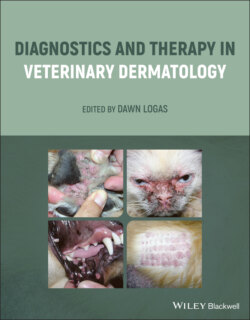Читать книгу Diagnostics and Therapy in Veterinary Dermatology - Группа авторов - Страница 40
Primary and Secondary Lesions
ОглавлениеDifferentiating between primary and secondary lesions can help develop the differential diagnosis list. Primary lesions develop spontaneously as a direct result of the underlying disease. The following are primary lesions:
Papule: elevated domed skin lesion <1 cm
Plaque: elevated skin lesion with a flat top >1 cm
Nodule: elevated domed skin lesion >1 cm that is solid and typically extends to deeper skin layers
Pustule: small, circumscribed elevation of skin containing pus
Vesicle: circumscribed elevation of skin filled with fluid <1 cm
Bulla: circumscribed elevation of skin filled with fluid >1 cm
Macule: flat, distinct area of color change <1 cm
Patch: flat area of color change >1 cm
Wheal: elevation (often sharp) of the skin surface consisting of edema
Cyst: membranous cavity or sac containing fluid or solid material
Secondary lesions can develop from primary lesions or evolve from patient/external factors (such as medications or scratching). They can be helpful, as they may indicate primary lesions that are no longer present, e.g. ulcer developing from vesicle or bulla. The following are secondary lesions:
Epidermal collarette: circular ring of crust or scale (may be secondary to a pustule or new evidence suggests some may be primary lesions)
Lichenification: hardened, thickened skin that is often a response to chronic inflammation or friction
Erosion: epidermal defect that does not penetrate the basal laminar zone
Ulcer: epidermal defect that exposes underlying dermis (deeper than erosion)
Excoriation: erosion/ulcer caused by scratching (often linear), rubbing, or biting
Fissure: cleavage into epidermis or dermis
Callus: thickened, hyperkeratotic, alopecic plaque
Scar: fibrous tissue that has replaced damaged dermis or subcutaneous tissue
Some lesions can be either primary or secondary. For instance, alopecia is a primary lesion in cases of hypothyroidism, but is secondary when caused by scratching. The following are primary or secondary lesions:
Alopecia: loss of hair
Comedo: hair follicle that is dilated and filled with sebaceous material and cornified cells
Follicular casts: keratin and follicular material accumulation that adheres to hair shaft and extends beyond the surface of the follicular ostia
Crust: dried exudate, serum, cells, blood, pus, and other materials adhered to skin
Scale: loose fragments of cornified cells that accumulate on the skin surface
Hyperpigmentation: darkening of skin color
Hypopigmentation: lightening of skin color
